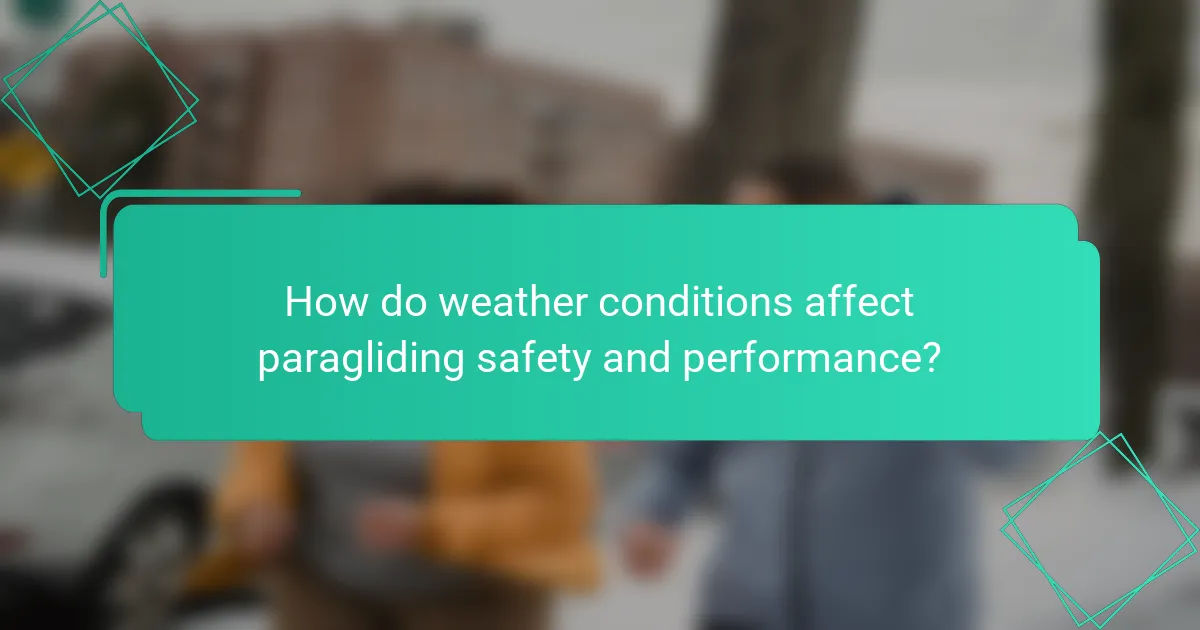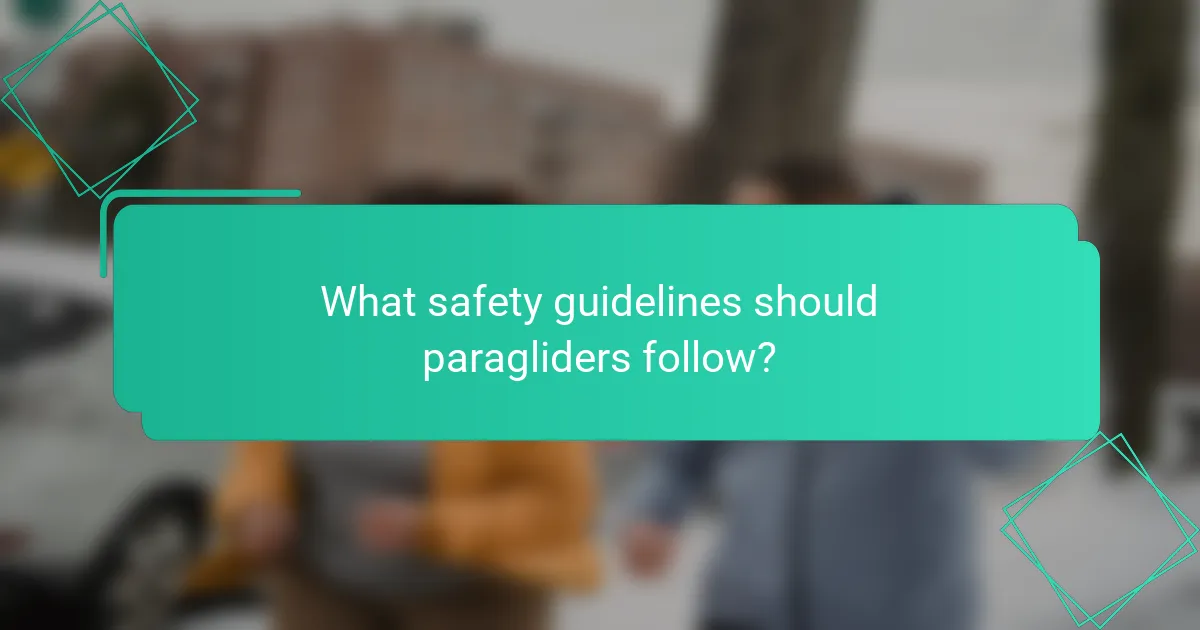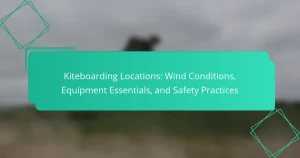Discover the best paragliding locations that offer stunning views, ideal weather conditions, and established safety guidelines. Explore popular sites like Chamonix, Interlaken, and Oludeniz. Learn how weather impacts safety and performance, and understand essential safety protocols to ensure a secure flying experience. Prioritise locations with favourable conditions for both novice and experienced pilots.

What are the most popular paragliding locations around the world?
The most popular paragliding locations globally include Chamonix in France, Interlaken in Switzerland, and Oludeniz in Turkey. These sites offer stunning views, favourable weather conditions, and established safety guidelines.
Chamonix features the breathtaking Mont Blanc, attracting many paragliders. Interlaken is known for its picturesque lakes and mountains. Oludeniz boasts a unique turquoise sea backdrop, enhancing the paragliding experience.
Weather conditions play a crucial role; ideal locations have consistent thermals and minimal turbulence. Safety guidelines are well-established in these areas, ensuring a secure adventure for both beginners and experienced paragliders.
Which locations offer stunning scenic views for paragliding?
The best paragliding locations for stunning scenic views include Interlaken in Switzerland, Queenstown in New Zealand, and Oludeniz in Turkey. These sites offer breathtaking landscapes, ideal weather conditions, and established safety guidelines.
Interlaken provides views of the Swiss Alps, while Queenstown showcases Lake Wakatipu and surrounding mountains. Oludeniz features the famous Blue Lagoon, enhancing the paragliding experience with its vibrant colours and unique geography.
How do regional landscapes influence paragliding experiences?
Regional landscapes significantly enhance paragliding experiences by providing diverse scenic views, varying weather conditions, and specific safety considerations. Locations with mountains offer breathtaking vistas and thermals, while coastal areas provide unique wind patterns.
Weather conditions, influenced by regional topography, affect flight safety and enjoyment. For instance, mountainous regions may experience sudden weather changes, necessitating careful planning.
Safety guidelines must adapt to local terrain and weather. Paragliders should be aware of unique attributes such as altitude variations and local wildlife, which can impact flight dynamics.
Understanding these landscape influences is essential for paragliders to optimise their experiences and ensure safety during flights.
What unique features do specific locations provide for paragliders?
Specific paragliding locations offer unique features such as stunning landscapes, optimal weather conditions, and safety measures tailored for enthusiasts. Locations like the Swiss Alps provide breathtaking views and consistent thermals, while sites in New Zealand are known for their diverse terrains and favourable winds. Safety guidelines vary by region, ensuring that paragliders can navigate their surroundings effectively. Unique attributes, like local regulations and available support services, further enhance the experience for paragliders in different locations.

How do weather conditions affect paragliding safety and performance?
Weather conditions significantly impact paragliding safety and performance. Wind speed, thermal activity, and precipitation are critical factors.
Strong winds can create turbulence, increasing the risk of accidents. Ideal wind speeds for paragliding range from 5 to 15 mph. High thermal activity helps lift, enhancing performance but can also lead to unpredictable conditions. Pilots should avoid flying in thunderstorms or heavy rain, as these can decrease visibility and control.
Understanding local weather patterns is essential for safe paragliding. Regularly checking forecasts and using weather apps can help pilots make informed decisions.
What are the ideal weather conditions for paragliding?
The ideal weather conditions for paragliding include clear skies, light winds, and stable air. Optimal wind speeds range from 5 to 15 mph, while temperatures between 15°C and 27°C enhance comfort and performance. Avoid flying in turbulent weather, heavy rain, or strong gusts, as these conditions pose safety risks.
How do seasonal changes impact paragliding locations?
Seasonal changes significantly impact paragliding locations by altering weather conditions and scenic views. Different seasons provide varying thermal currents, wind patterns, and visibility, which are crucial for safe flying.
In spring, locations often experience mild weather, enhancing visibility and creating optimal thermal conditions for soaring. Summer can bring stronger winds and turbulence, potentially challenging for novice pilots. Autumn offers stunning foliage, but weather patterns can become unpredictable. Winter typically limits paragliding opportunities due to cold temperatures and snow, reducing safety and accessibility.
Understanding these seasonal variations helps pilots choose the best times and locations for paragliding, ensuring both safety and enjoyment.
What weather-related challenges should paragliders anticipate?
Paragliders should anticipate challenges such as strong winds, turbulence, and sudden weather changes. These conditions can impact flight safety and performance.
1. Strong Winds: High winds can create dangerous conditions, making takeoff and landing difficult.
2. Turbulence: Thermal and mechanical turbulence can disrupt smooth flying, affecting control.
3. Rain: Sudden rain can reduce visibility and increase the risk of accidents.
4. Temperature Changes: Rapid temperature shifts can alter air density, influencing lift and glide performance.
5. Storms: Thunderstorms pose significant risks, including strong downdrafts and lightning.
6. Fog: Reduced visibility in fog can complicate navigation and landing.

What safety guidelines should paragliders follow?
Paragliders should adhere to safety guidelines that prioritise equipment checks, weather assessment, and location awareness. Ensure gear is properly maintained, including wings, harnesses, and reserve parachutes. Check weather conditions to avoid turbulence and strong winds. Familiarise yourself with the landing area and potential hazards. Always fly with a buddy for added safety.
How can paragliders prepare for emergencies?
Paragliders can prepare for emergencies by conducting thorough pre-flight checks, understanding weather conditions, and practicing emergency landing techniques. Familiarity with the location is crucial, including identifying safe landing zones. Carrying essential gear, such as a reserve parachute, enhances safety. Regular training on emergency procedures ensures readiness.
What equipment is essential for safe paragliding?
Essential equipment for safe paragliding includes a well-constructed paraglider, harness, helmet, reserve parachute, and variometer. Each item plays a crucial role in ensuring safety during flight. A reliable paraglider provides stability, while a quality harness supports the pilot. A helmet protects against head injuries, and a reserve parachute is vital for emergencies. A variometer helps monitor altitude and descent rate, enhancing situational awareness.
Which organizations provide safety training for paragliders?
Organizations providing safety training for paragliders include the United States Hang Gliding and Paragliding Association (USHPA), the British Hang Gliding and Paragliding Association (BHPA), and the Paragliding Association of Canada (PAC). These organizations offer courses covering essential safety guidelines and skills for safe flying. Additionally, many local flight schools and clubs provide tailored training programs to enhance safety awareness and practical skills for paragliders.

What are the common risks associated with paragliding?
Paragliding carries risks including weather changes, equipment failure, and terrain hazards. Understanding these risks enhances safety and enjoyment.
Weather conditions significantly impact paragliding safety. Sudden wind shifts or storms can lead to dangerous flying conditions. Pilots should always check forecasts and avoid flying in adverse weather.
Equipment failure poses another risk. Regular maintenance and checks are essential to ensure that paragliding gear functions correctly. Pilots should be familiar with their equipment and perform pre-flight inspections.
Terrain hazards include obstacles like trees, power lines, and cliffs. Choosing safe landing zones is crucial to reduce the risk of accidents. Pilots should scout locations beforehand to identify potential hazards.
How can paragliders mitigate risks during their flights?
Paragliders can mitigate risks by assessing weather conditions, choosing suitable locations, and adhering to safety guidelines. Understanding local weather patterns helps avoid dangerous situations. Selecting scenic locations with open landing areas reduces obstacles. Following safety guidelines, such as pre-flight checks and using proper equipment, enhances flight safety. Regular training and community engagement also contribute to risk management.
What role does experience play in paragliding safety?
Experience significantly enhances paragliding safety by improving decision-making and risk assessment. Experienced pilots can better evaluate weather patterns, terrain, and equipment performance, reducing the likelihood of accidents. They also develop skills to manage unexpected situations effectively, which is crucial for maintaining safety in varying conditions. Furthermore, seasoned paragliders often understand the importance of adhering to safety guidelines and can identify potential hazards more readily than novices.

What are the best practices for novice paragliders?
Novice paragliders should prioritise locations with favourable weather, stunning views, and robust safety guidelines. Choose sites known for consistent wind patterns and open landscapes to enhance your experience. Familiarise yourself with local regulations and seek guidance from experienced pilots. Always check weather forecasts and be aware of changing conditions to ensure a safe flight.
How can beginners choose their first paragliding location?
Beginners should choose paragliding locations based on scenic views, favourable weather conditions, and established safety guidelines. Look for sites with beautiful landscapes, consistent wind patterns, and access to experienced instructors. Popular beginner-friendly locations often have clear landing zones and supportive communities. Prioritise places known for their safety records and amenities for novice pilots.
What tips do experienced paragliders recommend for novices?
Experienced paragliders recommend focusing on safety, choosing the right locations, and understanding weather conditions. Prioritise training with certified instructors. Select scenic sites with ample landing zones. Check local weather patterns for wind and thermal conditions. Always wear appropriate gear and ensure your equipment is well-maintained.
What common mistakes should new paragliders avoid?
New paragliders should avoid common mistakes like inadequate preparation, neglecting weather conditions, and ignoring safety guidelines. These errors can lead to accidents and diminished enjoyment.
1. Skipping pre-flight checks can result in equipment failure.
2. Underestimating weather changes may lead to dangerous flying conditions.
3. Failing to communicate with experienced pilots limits learning opportunities.
4. Ignoring local regulations can result in legal issues.
5. Not practicing landing techniques can lead to injuries.


